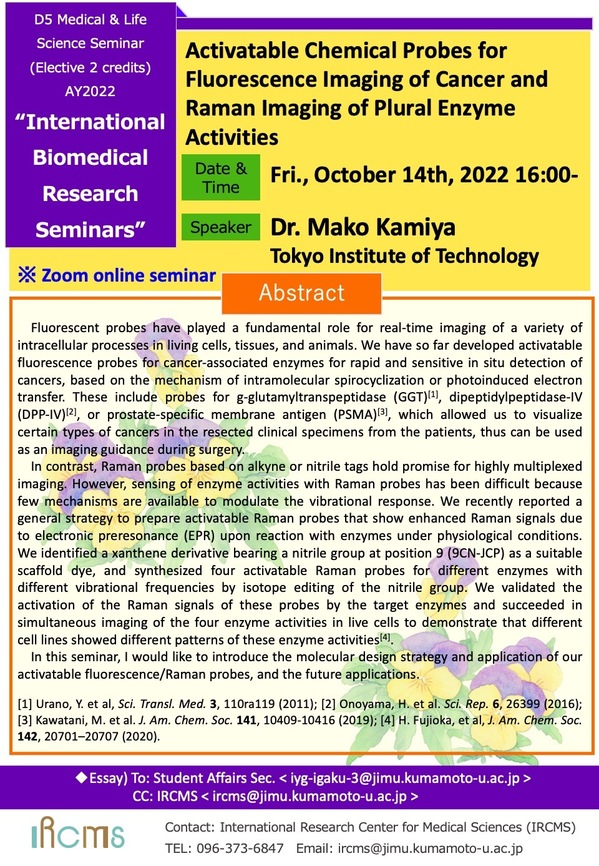- HOME
- News & Events
- [Oct. 14] D5 Medical & Life Science Seminar - Dr. Mako Kamiya (Tokyo Institute of Technology)
News & Events
[Oct. 14] D5 Medical & Life Science Seminar - Dr. Mako Kamiya (Tokyo Institute of Technology)
October 6 2022
The "D5 Medical & Life Science Seminar" course will be offered by International Research Center for Medical Sciences (IRCMS). It will run from May 2022 to March 2023, with lectures given by scientists who are affiliated with IRCMS or in collaboration with researchers at IRCMS. The lectures will be given once a month, in English, and by leading scientists in the relevant research field. Students will be taught: 1) how normal physiological functions are maintained in the human body; 2) how these systems become abnormal under certain pathophysiologic conditions; 3) why stem cells are important in animal development and homeostasis; 4) how stem cell-based approaches can help us understand disease mechanisms and find potential cure for diseases related to stem cell malfunction (e.g., cancer, aging).
Anyone who wants to join is welcome.
For students who have registered for the course, please check your attendance in Moodle.
Date : October 14th, 2022 (Friday)
Time : 16:00 -
* Zoom online seminar
Speaker : Dr. Mako Kamiya
Tokyo Institute of Technology
Title : Activatable Chemical Probes for Fluorescence Imaging of Cancer and Raman Imaging of Plural Enzyme Activities
Abstract :
Fluorescent probes have played a fundamental role for real-time imaging of a variety of intracellular processes in living cells, tissues, and animals. We have so far developed activatable fluorescence probes for cancer-associated enzymes for rapid and sensitive in situ detection of cancers, based on the mechanism of intramolecular spirocyclization or photoinduced electron transfer. These include probes for g-glutamyltranspeptidase (GGT)[1], dipeptidylpeptidase-IV (DPP-IV)[2], or prostate-specific membrane antigen (PSMA)[3], which allowed us to visualize certain types of cancers in the resected clinical specimens from the patients, thus can be used as an imaging guidance during surgery.
In contrast, Raman probes based on alkyne or nitrile tags hold promise for highly multiplexed imaging. However, sensing of enzyme activities with Raman probes has been difficult because few mechanisms are available to modulate the vibrational response. We recently reported a general strategy to prepare activatable Raman probes that show enhanced Raman signals due to electronic preresonance (EPR) upon reaction with enzymes under physiological conditions. We identified a xanthene derivative bearing a nitrile group at position 9 (9CN-JCP) as a suitable scaffold dye, and synthesized four activatable Raman probes for different enzymes with different vibrational frequencies by isotope editing of the nitrile group. We validated the activation of the Raman signals of these probes by the target enzymes and succeeded in simultaneous imaging of the four enzyme activities in live cells to demonstrate that different cell lines showed different patterns of these enzyme activities[4].
In this seminar, I would like to introduce the molecular design strategy and application of our activatable fluorescence/Raman probes, and the future applications.
[1] Urano, Y. et al, Sci. Transl. Med. 3, 110ra119 (2011); [2] Onoyama, H. et al. Sci. Rep. 6, 26399 (2016); [3] Kawatani, M. et al. J. Am. Chem. Soc. 141, 10409-10416 (2019); [4] H. Fujioka, et al, J. Am. Chem. Soc. 142, 20701-20707 (2020).

